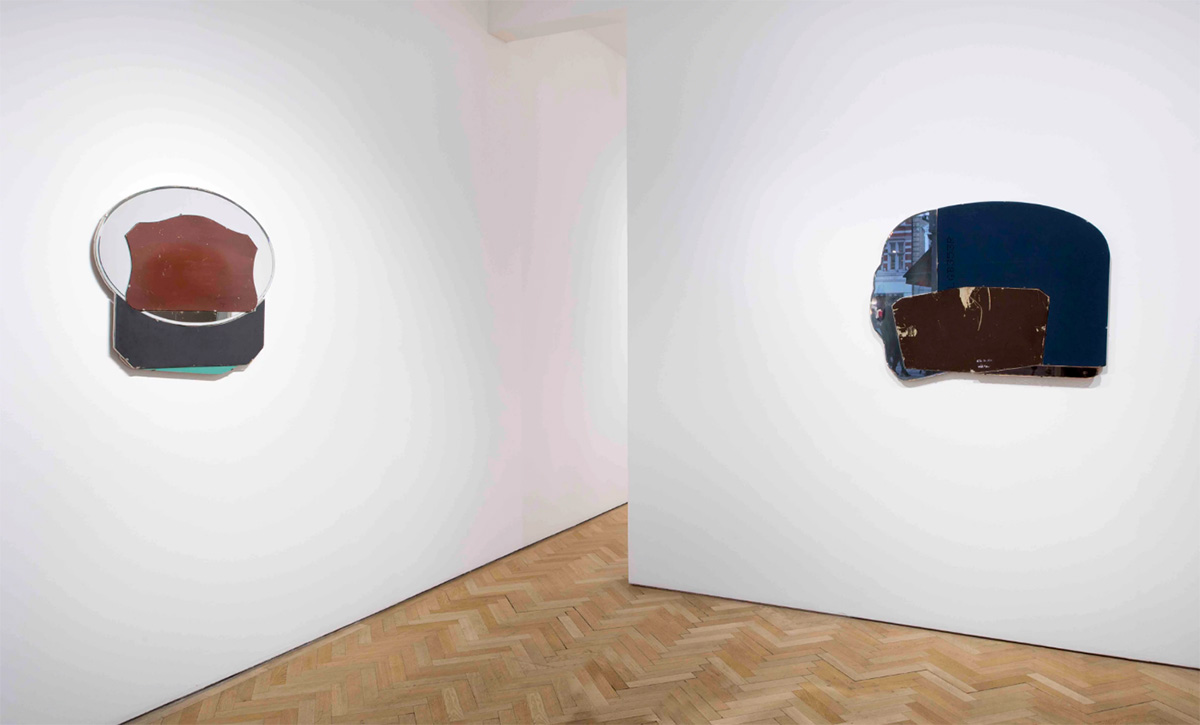(▲ Untitled #1, 2012, Found glass, lead and steel, 160 x 94 x 1 cm, 63 x 37 1/8 x 3/8 inches – Magia Naturalis, 2017, Salvaged mirrors, 91 x 92 cm, 35 7/8 x 36 1/4 inches)
Exhibition runs from the 12 January – 10 February 2018
The Mirror’s place in science, magic and myth is well documented. This exhibition, Krokatsis’s first with Vigo showcases seven new works. These use materials that Krokatsis has returned to regularly since 2007 – old mirrors, their backs and also found glass – materials that are overlooked, redundant and seemingly insignificant. These though, are less flamboyant than their ancestors- more restrained, more focused on the value of imperfection.
“I’m not interested in perfection, I’m drawn to the imperfect. Imperfection holds fluidity and unpredictability. Critically, imperfection stirs empathy. Making these works is a way to interrogate my ideas about the instability of our relationship to permanence. They’re also a way of playing with the sensory and emotive qualities of materials and pre existing objects to create a perceptual transformation. This leads us towards understanding the nature of change – what we perceive as stable and unstable.”
H. Krokatsis in discussion with E.Kelley
 (▲ Household Faith, 2017, Salvaged mirrors, 75 x 79 cm, 29 1/2 x 31 1/8 inches – Superbia, 2017, Salvaged mirrors, 87 x 102 cm, 34 1/4 x 40 1/8 inches)
(▲ Household Faith, 2017, Salvaged mirrors, 75 x 79 cm, 29 1/2 x 31 1/8 inches – Superbia, 2017, Salvaged mirrors, 87 x 102 cm, 34 1/4 x 40 1/8 inches)
These mirrors have been retrieved, meticulously cut to fit into each other and wall hung to create a delineated surface, bringing them, awkwardly, into the realm of painting. Krokatsis manages to transform not just these objects’ material nature but also their functionality and status. Presented in this way, rather than look into them, we look at them, their neutral indifference disappearing as one begins to compare the subtleties in their surfaces, much as one examines the surface of a painting; age, patina and technology bearing down on the relative qualities of reflection.
These works exist at the intersection of the spiritual and the mundane. They traverse the border and exploit the gap between a functional object and an object of aesthetic fascination. Because of this, it’s more useful to see them not as art to make sense of the world but rather as art as a spell, as an act of faith.
Although mirrors (especially these, found in junk shops and car boot fairs) belong to the commonplace, they were once regarded as sacred objects, mystical instruments for finding the truth. Later they transformed into secular objects of great value. At the beginning of the 16th century an elaborate Venetian mirror at auction was valued at 3 times the price of a painting by Raphael. Today, because they are common and because of their perceived neutrality, we pay the mirrors around us little attention, although they create amongst other things, identity, illusion, vanity and imitation.
 (▲ untitled, 2017, Salvaged mirrors, 74 x 62 cm, 29 1/8 x 24 3/8 inches – MUEIN , 2017, Salvaged mirrors, 73 x 98 cm, 28 3/4 x 38 5/8 inches)
(▲ untitled, 2017, Salvaged mirrors, 74 x 62 cm, 29 1/8 x 24 3/8 inches – MUEIN , 2017, Salvaged mirrors, 73 x 98 cm, 28 3/4 x 38 5/8 inches)
Some of these mirrors are turned, showing the cadmium, copper or aluminium coated back -opening up it’s own peripheral history. The Etruscans for example, engraved the back of bronze polished hand mirrors with scenes of daily life, myths and erotica. These engravings became important, collectible and continued to be made always on the back of a mirror though they really didn’t need to be.
In the Jewish tradition, when a family member dies, all the mirrors in the house are turned around to face the wall, backs showing. There are many theories as to why – the Kabbalists reason that dark spirits come to visit families in mourning, they enter and become visible through mirrors so turning them is a way of preventing these spirits from entering. Another theory is that they are turned because mirrors reflect the physical, and mourning is a time for spiritual contemplation.
Front and back, these materials offer many associations to play with. It’s these associations that Krokatsis works with – the elements that are cut loose, allowed to drift and resettle, transfiguring the commonplace.
For Household Faith inquiries please contact info@vigogallery.com
VIGO
T: + 44 (0)20 7493 3492
21 Dering Street London W1S 1AL
info@vigogallery.com
vigogallery.com
#vigogallery

